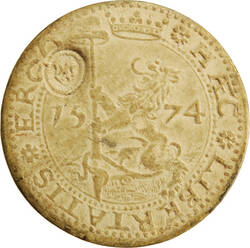This coin is a genuine rarity, because it's made not of metal, but of parchment.
Until the 19th century, gold, silver and copper were the main coinage metals. However, in wartime, the supply of ordinary coins in a town under siege could quickly run out. To carry on paying the soldiers and keep trade ticking over, the authorities would issue temporary emergency money – usually made of an alloy of lead and tin, or of iron. Or, as in this case, of parchment. This particular siege coin was issued by the city of Leiden.
The coins were made by glueing several pages of old ecclesiastical volumes together, punching out the blank and then striking the coin.
This one shows a lion with a lance between its paws. Hanging on the tip of the lance is a cap called a "pileus", an emblem of liberty. In ancient Rome, this type of cap was worn by freed slaves. At the top of the coin on the left, you can see a small oval countermark with a lion crest. That's the mark of the Province of Holland. It was meant to guarantee that the money was genuine.
The city of Leiden was besieged by Spanish troops in 1574. Several years earlier, the northern provinces of the Netherlands had launched the battle for their independence from Spain. Leiden joined the uprising in 1572. The city came under siege shortly afterwards. It was only when the dykes were broken and the surrounding polders were deliberately flooded in early October 1574 that the Spanish troops were forced to flee.
Further Media
- Location & Dating
- Netherlands, Leiden, 1574
- Material & Technique
- Parchment, embossed, counterstamp on the reverse: in a circle of pearls a coat of arms with a lion rising to the left; gap at the edge (see comm. condition)
- Dimenions
- Diameter: 37,1 mm; weight: 2,05 g
- Museum
- Münzkabinett
- Inventory number
- EUF1999
